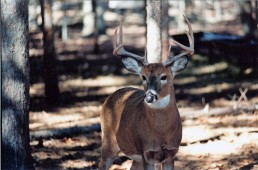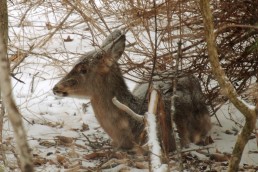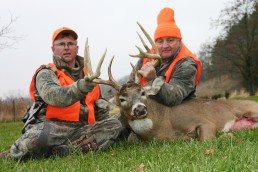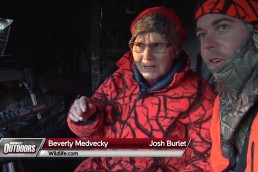Finding Big-Deer Habitat
SHARE THIS POST
The fresh, forest air is filled with the scent of pine and cedar. The morning chill bites through my coat. Suddenly, the crunch of dry leaves beneath my feet sounds like I was walking on corn flakes. There he is, marching in like he owned half the zip code. My months of scouting for that big deer were about to pay off.
Then two rifles barked—and he was gone. Both had missed. I looked around, and it seemed that every tree had an orange bundle perched high in its limbs. I had forgotten one important element of my scouting program: Hunter population.
What makes ideal big-buck habitat? A variety of areas qualify.
The five essential elements are food, water, cover, minimal intrusion, and sanctuary.
There are two types of feeding areas. One is a hunting area that ideally goes back into timber where deer have the security of cover on all sides. They are usually kind of secluded. If you open them up, you can make them accessible to putting your stands where you remove the negative effects of prevailing wind conditions.
The other type of feeding area is important on a small tract of land. If you have a small tract of land, you are dependent to some degree on the tracts of land around you. You want to attract to your land the greatest number of deer that your land can possibly hold. Those are recruiting areas.
Recruiting areas must be in places where they attract the greatest number of deer. They will be out in the open.
Warm season grasses are great cover. You cannot see through it, but it makes a tremendous fawning area. It makes good dry bedding.
Select cutting of timber is another good way to create cover. When you harvest timber, you end up with a thick, nasty area. It allows more sunlight to reach the forest floor. which allows for more undergrowth creating cover.
Water is the life blood of animals. Water can also be like a feeding area. Where found, it effects where deer approach the water holes. Some watering holes, called rut watering holes, are where the does go to water. He will follow.
Vigilant hunters place their stands in relationship to both water holes and the fields where the deer are feeding. If the ground seeps and does not hold water very long, a plastic liner covered with some dirt will hold water for a long time. Another way is to use a child’s pool, place some dirt in it, and stick it in the ground. Deer seem to prefer stagnant water rather than going to a creek. In winter, break a hole in the ice, and deer will come to drink.
For an area to be the core of a deer’s range, it must have water of some sort.
Minimum intrusion is the key to holding deer year-round. If you are in there all the time, the deer will not stay.
Minimal intrusion means no ATV or recreational vehicle use. If you wish to consistently harvest big bucks, stay out. It also means no coon hunting on the property. Deer and dogs do not get along. Dogs are predators and deer are prey.
Are you enjoying this post?
You can be among the first to get the latest info on where to go, what to use and how to use it!
Some deer will leave and some will come back. But that old 7-year-old buck will stay if there is minimal intrusion.
Minimal intrusion also means no timber cutting, no 3-D range, no sighting in of rifles, no hiking, no biking or other uses if your goal is to hold and grow bucks on a small tact. It means creating a sanctuary area in the center of a property and never, ever going into it.
Every time that you bump a deer, it reduces chances of harvesting a deer in that location. It may not affect them at all. But it may reduce the chances of seeing them again in that location. When you bump a doe, she will blow at you. The next time, she will be looking for you at that location. She will either follow your track, or maybe she will circumvent you. Where bucks go and what they do during the rut is dependent upon what those does are doing. So, if the does are circumventing you, so too will the bucks.
The biggest fear is that you push that buck over to the next farm. We must be careful not to bump them.
Minimal intrusion also is important in the placement of trail cameras and collecting the cards from them for examination at home. Cameras need to be set in places where you can get in and out again with the least amount of intrusion.
When you place cameras, it is important to not do so in a bad wind, just like when hanging a stand. Watch from a distance, rather than going into the area to scout. When possible, use binoculars instead of walking into your hunting area.
Try to monitor which bucks are visiting which places. Attempt to determine what conditions exist as to wind direction, etc., and at what time of the day deer are using the area. Monitor everything. Check the direction they enter and leave as well as moon conditions. Write it all down for future reference.
If you are just hunting, you need to be in the field. But if you are hunting big bucks, you need to hunt less, but more strategically. Do not over-hunt an area.
Early in the season, hunt the fringe areas and save your best areas for times when they are most active with big buck movement. That way, you do not burn your best spots before they are prime locations.
One of the ways to hunt fringe is from a box blind. Another is to hunt fence rows. Deer follow thethem looking for a way to cross over.
When using scent attractants, put it in a container and take it with you on each trip. Otherwise, do not use them. Most scent attractants eventually contaminate your area if you leave them out. As scents break down, they take on an odor of ammonia. Deer do not want to be around that smell and it will eventually drive them out.
Rattling in a small area should only occur sparingly. Your chances of exposure are too great. Most of the time, a buck approaches the sound of two woodland studs fighting from downwind. Most hunters will not even know of their exposure. Try to set up in a position where your back is to some type of cover where you cannot be surprised.
Big deer are out there, and some hunters find them. If you want to find them, plan your probe into their territory using some of these tips.
MWO
SHARE THIS POST
Did you enjoy this post?
You can be among the first to get the latest info on where to go, what to use and how to use it!
Don Gasaway
Don Gasaway is a veteran freelance outdoor writer from Marion, Ill. He may also be found at: https://www.facebook.com/DonGasawayWriter and facebook.com/Wandering Angler. Comments are welcome



